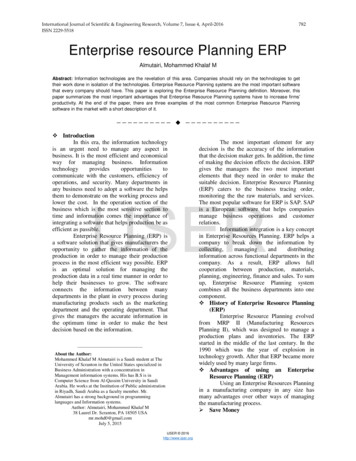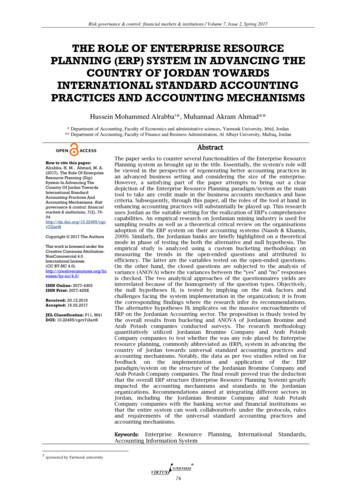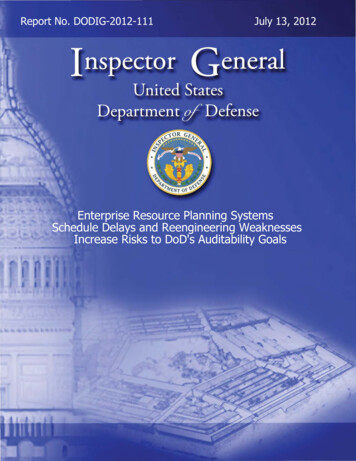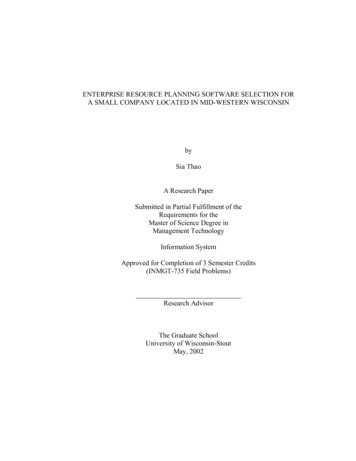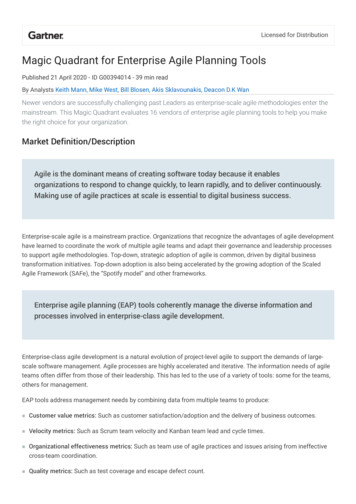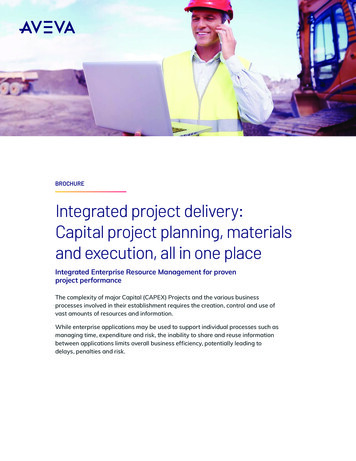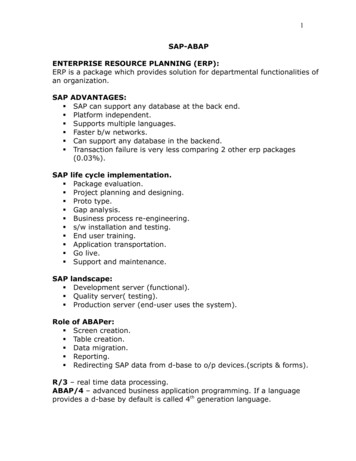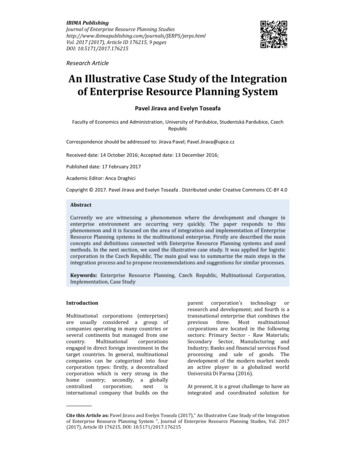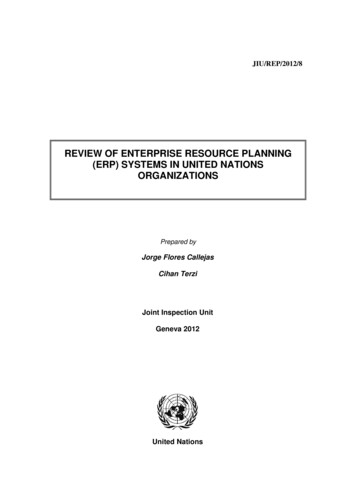
Transcription
JIU/REP/2012/8REVIEW OF ENTERPRISE RESOURCE PLANNING(ERP) SYSTEMS IN UNITED NATIONSORGANIZATIONSPrepared byJorge Flores CallejasCihan TerziJoint Inspection UnitGeneva 2012United Nations
JIU/REP/2012/8Original: ENGLISHREVIEW OF ENTERPRISE RESOURCE PLANNING(ERP) SYSTEMS IN UNITED NATIONSORGANIZATIONSPrepared byJorge Flores CallejasCihan TerziJoint Inspection UnitUnited Nations, Geneva 2012
iiiEXECUTIVE SUMMARYReview of enterprise resource planning (ERP) systems in United Nations organizationsJIU/REP/2012/8The objective of this report is to review the implementation, use, maintenance, evolution,upgrade and extension of existing ERP systems in the United Nations organizations, andestablish success factors for enhancing their sustainability and flexibility to evolving userrequirements and technology. The review aims to help organizations improve their ERPsystems as well as their benefits; identify system-wide opportunities to share, harmonize andstandardize ERP operations between the organizations; share services or merge componentsof systems in order to maximize synergies across the system; and strengthen the position ofthe United Nations organizations in their relations with ERP providers. In doing so, the reportassesses the efficiency, effectiveness, value added, impact, user satisfaction, coherence andsustainability of ERP systems.The findings, conclusions and recommendations of the present review build on previousrelated Joint Inspection Unit (JIU) reports, as well as on current and previous studies on theimplementation of ERP systems in the United Nations structure.Main findings and conclusionsImplementing an ERP system is a journey that requires strong project management techniquesand entails direct and indirect costs throughout the life cycle stages of the system. TheInspectors found that most organizations’ ERP systems were implemented over budget andover schedule, as a result of weak project planning and management, including: inadequatedefinition of functional requirements; unrealistic budget and schedule; changes in theproject’s scope; delay in data conversion and business process re-engineering; users’resistance to change; and unforeseen customization costs. The Inspectors concluded thatorganizations need to better follow success factors identified in this report, share lessonslearned within the system and enhance inter-agency collaboration for ERP support to achievemore cost-efficient ERP implementation, maintenance and growth.The Inspectors realized that most United Nations organizations initially opted for a highlycustomized ERP, as managers were reluctant to redesign business processes. At the time ofthe upgrade, they would reimplement or upgrade the system in a less customized manner, dueto the high costs associated with the maintenance and upgrade of customized systems, and tousers’ learning curve, which permitted better user acceptance of a less customized system.The Inspectors also found that high customization of ERP systems had a negative impact onERP systems’ usability and accessibility. The Inspectors concluded that organizations shouldeffectively re-engineer their business processes and limit ERP customizations, taking theopportunity of upgrades to revisit business processes.Regarding costs, the Inspectors noticed that each organization measured ERP costsdifferently, making it very difficult to assess the total cost of ownership of ERP systems.Indirect costs tended to be omitted from ERP projects’ budget, as well as the projection ofmaintenance and upgrade costs, despite the fact that they constitute the biggest costproportion in an ERP system’s life cycle and that there is a direct causal relationship betweenthe initial customizations made to such a system and its future maintenance and upgradecosts. The Inspectors concluded that to ensure effective governance of ERP projects,organizations should define a realistic cost plan, including the ERP total cost of ownershipelements as well as contingencies. Adequate funding should be provided accordinglythroughout the project life.
ivThe Inspectors also found that most organizations do not measure quantitatively ERP benefitsand cost savings or cost avoidance, although many reported that ERP allowed thestreamlining and harmonization of business processes across organizations’ duty stations, aswell as efficiency gains and improved information management and reporting. ERP alsoenhanced internal controls and the availability of timely and consolidated financial data,notably supporting the strengthening of financial controls. The Inspectors concluded thatsince ERP projects represent major investments for the organizations, they require closemonitoring and reporting mechanisms on the progress of implementation and achievement ofexpected benefits.The Inspectors observed that the extent to which ERP systems had a positive impact onorganizations in which they were implemented depended on the implementation approach,change management and training strategy that had been implemented; users’ learning curve;data governance; internal controls that had been built into the system; users’ accessibility tothe system; and organizations’ capacity to collect and review users’ feedback once the systemhad been implemented.The Inspectors found that ERP projects were impinged by a lack of appropriate training ofmanagers, key ERP staff and end users before and after ERP implementation. Lack of trainingresulted in managers’ and users’ resistance to change, data inaccuracy and reporting andinternal control issues. The Inspectors concluded that adequate training on the benefits andfunctionalities of ERP should be provided to existing and future managers, key ERP staff andend users throughout the ERP life cycle, and that appropriate resources should be allocated totraining on an ongoing basis. Moreover, the Inspectors realized that the lack of internalcontrols in the system also resulted from the lack of ongoing feedback mechanisms followingERP implementation. The Inspectors concluded that organizations should constantly monitorusers’ feedback and strengthen the internal oversight of ERP systems, to identify and addressarising issues and risks. Also, to mitigate internal controls risks, staff roles and responsibilitiesshould be redefined in accordance with ERP business processes, and managers should be heldfully accountable for electronic approvals made in the system.Regarding coherence, the Inspectors noticed that although there is no coherent United Nationsstrategy regarding ERP implementations, ERP has led to a certain degree of harmonization ofbusiness processes across the United Nations system, due to a number of factors, including:the implementation of more “vanilla” (uncustomized) ERP systems over time; theconvergence of functionalities offered by ERP providers; the possibility of integratingdifferent systems; the sharing of ERP systems among some of the organizations; andInternational Public Sector Accounting Standards (IPSAS) implementation. The Inspectorsfound that the fact that organizations have different rules and regulations, charts of accountsand reporting practices was one of the main issues preventing greater ERP coherence. TheInspectors concluded that the Secretary-General, in his capacity as Chairperson of the UnitedNations System Chief Executives Board for Coordination (CEB), should speed up the effortsof the High-level Committee on Management (HLCM) to harmonize business processesacross the United Nations system, with a view to enhancing organizations’ efficiency andeffectiveness. As technology evolves and the ERP systems implemented gain more maturityin use, it will be possible in the future to use one ERP, as illustrated by Procter and Gamble’sERP experience.Moreover, the Inspectors observed that in the ERP market, suppliers have a disproportionateamount of negotiating power relative to customers, and that the CEB HLCM should establisha task force to review system-wide opportunities for ERP collaboration, and better positionUnited Nations system organizations vis-à-vis ERP providers.
vThe report contains four recommendations: one addressed to the Secretary-General as head ofthe CEB, one for the consideration of legislative/governing bodies and two addressed toexecutive heads of United Nations system organizations.Recommendation for consideration by legislative and governing bodiesRecommendation 2The legislative/governing bodies of United Nations system organizations should exercisetheir monitoring and oversight role on their respective ERP projects on an ongoingbasis, including implementation, maintenance and growth policy, cost-efficiency andachievements of the overall objectives of the projects.
viCONTENTSEXECUTIVE SUMMARY.ABBREVIATIONS. .ChapterParagraphs1–14I. INTRODUCTION.A. Background .1–6(a) Related General Assembly resolutions and ACABQ reports7(b) Related JIU reports and key issues raised.8B. Objectives and scope .9-10C. Methodology .11-1415-76II. IMPLEMENTATION AND MAINTENANCE.A. Overview .15–1920–29B. Costs .30–76C. Efficiency .32–39(a) Project planning and software selection.(b) Implementation approach and business process re40–45engineering .46–48(c) Project governance .49–50(d) Risk management.51–52(e) Change management .53–54(f) Project staffing.55–63(g) User training and support.64–69(h) ERP hosting and infrastructure .70(i) Data conversion and systems integration.71–73(j) ERP upgrades.74–76(k) Auditing .77–107III. USE AND IMPACT .A. ERP use .77–83B. Effectiveness.84–91(a) Expected ERP benefits .84(b) Monitoring and reporting on ERP achievements.85–9192–107C. Impact and value added .92–94(a) Streamlined and integrated business processes .95–98(b) Improved information management and reporting .99–103(c) Efficiency gains.104–107(d) Built-in internal controls .108–130IV. COHERENCE AND SUSTAINABILITY .A. Coherence and collaboration .108–123(a) Harmonization and efficiency .108–114115–117(b) Collaboration in ERP support .118–123(c) Negotiations with ERP providers.B. Sustainability .124–130ANNEXESI. Summary of relevant parts of previous JIU reports related to ERP .II. ERP and IPSAS implementation status in United Nations systemorganizations .III. Main reasons why ERP systems were implemented over budget andover schedule in United Nations organizations.IV. ERP implementation and maintenance costs.V. Main findings from user focus groups conducted during the 212121232324242526262628282931344243
viiOverview of actions to be taken by participating organizations onVI. the recommendations of the Joint Inspection Unit.4551
PUWFPWHOWIPOWMOAdvisory Committee on Administrative and Budgetary QuestionsOracle’s Customer Advisory Board for International OrganizationsUnited Nations System Chief Executives Board for CoordinationComprehensive Nuclear-Test-Ban Treaty OrganizationDepartment of Field Supportenterprise risk managemententerprise resource planningFood and Agriculture Organization of the United NationsHigh-level Committee on ManagementInternational Atomic Energy AgencyInternational Civil Aviation OrganizationInternational Computing Centreinformation and communication technologyInternational Labour OrganizationInternational Monetary FundIntegrated Management Information SystemInternational Maritime OrganizationInternational Public Sector Accounting Standardsinformation technologyInternational Telecommunication UnionJoint Inspection Unitmemorandum of understandingOffice for the Coordination of Humanitarian Affairsresults-based budgetingresults-based managementsoftware as a serviceSAP Special Interest GroupJoint United Nations Programme on HIV/AIDSUnited Nations Capital Development FundUnited Nations Development ProgrammeUnited Nations Educational, Scientific and Cultural OrganizationUnited Nations Population FundUnited Nations Human Settlements ProgrammeOffice of the United Nations High Commissioner for RefugeesUnited Nations Children’s FundUnited Nations Industrial Development OrganizationUnited Nations Staff Joint Pension FundUnited Nations Office for Project ServicesUnited Nations Relief and Works Agency for Palestine Refugees in the NearEastUnited Nations UniversityUnited Nations Entity for Gender Equality and the Empowerment of WomenUnited Nations World Tourism OrganizationUniversal Postal UnionWorld Food ProgrammeWorld Health OrganizationWorld Intellectual Property OrganizationWorld Meteorological Organization
1I. INTRODUCTIONA.Background1.As part of its programme of work for 2012, the JIU conducted a review entitled “Review ofenterprise resource planning (ERP) systems in United Nations organizations”. This review builds onprevious related JIU reports, as well as on current and previous studies on the implementation of ERPsystems in the United Nations system.2.In general, ERP systems provide standard applications to manage the financial, human and physicalresources of a user organization, integrating data and business processes under a unified information systemsharing a common set of data. ERP systems are composed of modules by functional area, such as financeand accounting, human resources management and supply chain management that can be implemented instages. The modular design also allows the implementation of selected functions only. They are alsodesigned to include modifiable parameters that can, to some extent, be configured to reflect the specificitiesand workflows of organizations. Configuration options include settings such as the definition of the chart ofaccounts and fiscal periods, as well as parameters that drive business processes.3.Most United Nations organizations have invested in ERP systems to replace legacy systems, forcost containment reasons and to improve operational performance, efficiency and internal controls.Considering the available industry-wide solutions and their benefits, particularly when compared to othermeans of processing structured organizational data, ERP systems have the ability to automate and integratebusiness processes, share common data and practices across an organization, and produce and access realtime information.4.These systems offer organizations the opportunity to adopt good practices and have the potential toenhance operational efficiency, accountability and organizational performance. They provide a platformthat facilitates organizations’ adoption of new technology. Moreover, the ability to access ERP systems andtheir centralized, integrated databases through web browsers facilitates the outsourcing/offshoring ofsupport services/functions, as well as the development of centralized shared service centres for theprovision of those services/functions.5.ERP systems are considerably complex. Their implementation is often lengthy, cumbersome andcostly, involving considerable organizational change and numerous stakeholders, including informationtechnology personnel and representatives of service provider and user departments, as well as externalconsultants and system integrators – i.e. implementation partners. Such projects require an experiencedproject implementation team as well as effective project management, change management, governanceand risk management mechanisms.6.Organizations investing in ERP systems increasingly recognize the importance of improving themethods for evaluating the outcome of ERP implementation in terms of improved efficiency, effectivenessand organizational performance by establishing at the outset of the project clear, agreed goals andobjectives for the project and a fully developed business case for the ERP implementation, along with themeasures for determining success. These projects should be delivered on time, within budget and with theexpected functionalities, weighing the necessary trade-offs.(a) Related General Assembly resolutions and ACABQ reports7.In its reports on progress in the implementationAdvisory Committee on Administrative and Budgetaryincreased collaboration between the United Nationsorganizations. This collaboration could be viewed as aof the United Nations ERP project (Umoja), theQuestions (ACABQ) has consistently called forSecretariat and other United Nations systemlong-term option for lowering ERP costs in the
2future. The Secretary-General is mandated to pay particular attention to maximizing exchanges andsynergies between the organizations regarding their respective ongoing ERP initiatives, and to examine thefeasibility of convergence towards the adoption of common ERP solutions among the entities of the UnitedNations system in the long term (see A/65/576, para. 40, and A/66/7/Add.1, paras. 41–43. Thoserecommendations were endorsed by the General Assembly in its resolutions 65/259 and 66/246).(b) Related JIU reports and key issues raised8.This is the first system-wide ERP review carried out by the JIU. Nevertheless, over the past years,the JIU has conducted a number of reviews on issues related to the implementation of ERP systems acrossthe United Nations system organizations and/or their role in the delivery of administrative services. The JIUInspectors, in related reports, 1 have long held the view that the organizations of the United Nations systemcould greatly benefit from increased cooperation in the delivery of information systems and administrativeservices, both in terms of increased savings and efficiency gains as well as increased effectiveness. Theyhave consistently encouraged such cooperation, highlighting the need to share experiences amongorganizations; to standardize, simplify and harmonize business practices; to share common information andcommunication technology (ICT) and business solutions and strategies wherever possible; and to avoidcostly duplications.B.Objectives and scope9.The objective of this report is to review the implementation, use, maintenance, evolution, upgradeand extension of existing ERP systems in the United Nations system organizations, and establish successfactors for enhancing their sustainability and flexibility to evolving user requirements and technology. Thereview aims to help organizations improve their ERP systems as well as their benefits, and identify systemwide opportunities to share, harmonize and standardize ERP operations between the organizations, shareservices or merge components of systems in order to maximize synergies across the system, and strengthenthe position of the United Nations organizations in their relations with ERP providers. In doing so, thereview assesses the efficiency, effectiveness, value added, impact, user satisfaction, coherence andsustainability of ERP systems in the United Nations system.10.The scope of the review is system-wide, covering ERP implementation in all JIU participatingorganizations until mid-2012.C.Methodology11.In accordance with the internal standards and guidelines of the JIU and its internal workingprocedures, the methodology followed in preparing this report included a preliminary desk review,questionnaires, interviews and an in-depth analysis. A detailed questionnaire was sent to all participatingorganizations, and an online survey was also sent to the participants in the 2012 joint meeting of Oracle’sCustomer Advisory Board for International Organizations (CABIO) and the SAP Special Interest Group(SAP-SIG). 2 On the basis of the responses received, the Inspectors conducted interviews with officials of1Previous ERP-related JIU reports include the reports on a common payroll system; ICT governance; ICT hostingservices; offshore service centres; IPSAS preparedness; accountability frameworks; travel arrangements; and theMedical Service. Relevant parts of these reports are summarized in Annex 1, available at www.unjiu.org.2The joint CABIO/SAP-SIG meeting included over 100 participants – mainly IT (information technology)representatives from international organizations and sales representatives from Oracle and SAP. More details aboutthe methodology are available at www.unjiu.org.
3the participating organizations and also sought the views of other international organizations, including theInternational Monetary Fund (IMF) and the World Bank, and Procter and Gamble in the private sector. 312.The JIU was also given access to the survey responses collected in the framework of the Umojastudy on the implementation and ownership of ERP systems by United Nations organizations, 4 which werealso used for the drafting of this report. Moreover, the Inspectors conducted focus groups with users from asampling of organizations, selected according to the following criteria: Oracle and SAP users; select fielddriven and headquarters-based organizations; and organizations with a small and large workforce. Thefindings from users’ focus groups are summarized in Annex V.13.Comments from participating organizations on the draft report have been sought and taken intoaccount in finalizing the report. In accordance with article 11.2 of the Statute of the Joint Inspection Unit,this report was finalized after consultation among the Inspectors so as to test its conclusions andrecommendations against the collective wisdom of the JIU. To facilitate the handling of the report and theimplementation of its recommendations and the monitoring thereof, Annex VI contains a table indicatingwhether the report is submitted to the organizations concerned for action or for information. The tableidentifies those recommendations relevant for each organization, specifying whether they require a decisionby the organization’s legislative or governing body or can be acted upon by the organization’s executivehead.14.The Inspectors wish to express their appreciation to all who assisted them in the preparation of thisreport, and particularly to those who participated in the interviews and so willingly shared their knowledgeand expertise.II. Implementation and maintenanceA.Overview15.Among the JIU participating organizations reviewed, 13 are using Oracle and/or PeopleSoft, 5 sevenare using SAP and one is using Agresso. The International Telecommunication Union (ITU), which tookthe lead in finding a more sustainable and cost-efficient system, concluded that ERP was the best solutionfor its needs. At that time, the United Nations system organizations had not come up with a common ERPor customized solution.16.Other organizations followed ITU, and a wave of ERP implementations started in the 1990s, withthe Food and Agriculture Organization of the United Nations (FAO), the United Nations HighCommissioner for Refugees (UNHCR), the United Nations Children’s Fund (UNICEF) and the WorldFood Programme (WFP). However, United Nations system organizations are at different stages of ERP6implementation and some organizations are still without an ERP system. The way the same software isconfigured for each ERP instance varies according to each organization’s specific business needs andpractices.3With about 120,000 employees, 300 brands sold in 180 countries and operations in different regions in all continents,Procter and Gamble provided some similarities with the United Nations system, in terms of scale and complexity. Seehttp://www.pg.com/en US/downloads/company/PG GBS Factsheet.pdf4The full results of the Umoja survey are available on the JIU website.5Oracle includes Oracle Financials, PeopleSoft and Oracle E-Business Suite.6See Annex II.
417.It is important to note that the International Civil Aviation Organization (ICAO) is the onlyorganization using Agresso and that the United Nations Relief and Works Agency for Palestine Refugees inthe Near East (UNRWA) and the Comprehensive Nuclear-Test-Ban Treaty Organization (CTBTO) arecurrently working with WFP on the ERP design phase for an SAP-based solution. The United NationsWorld Tourism Organization (UNWTO) will study the possibility of introducing an ERP or anotherintegrated system after implementing the IPSAS. Figure 1 shows the use of ERP by organizations. 7Figure 1: ERP systems implemented across the United Nations system 818.Over time, the functionalities offered by Oracle and SAP are becoming more similar, and newtechnologies make it possible to interface different ERP systems. However, the benefits of ERP systemscan only be fully maximized if all the core business processes are run on the same instance, using a singledatabase, and if they are only interfaced with external systems for very specific business processes. Ageneral problem noted with ERP implementations is that not all of the business processes are handledinside the same system. Some organizations use both Oracle and SAP systems, 9 due to the fact that in theearly days of ERP, PeopleSoft – now Oracle – was better suited for human resources, and SAP foraccounting and finance. Since this is no longer true, it would be expected that in the long term, theseorganizations will run all their business processes in the same ERP.19.In very few cases, it is simpler and better to acquire specialized software rather than customizingthe ERP to meet very specific requirements, due to the nature of the business. For example, the UnitedNations Department of Field Support (DFS) Air Transport Section is in the process of acquiring specializedsoftware – ATMS – to deal with aircraft management, because it cannot be handled in the ERP.B.Costs20.Implementing an ERP is a journey that entails direct and indirect costs throughout the life cyclestages of the system. The total cost of ownership of an ERP consists of software and hardware acquisition7According to JIU questionnaires, almost 40,000 direct users are currently using Oracle, about 16,000 SAP, and lessthan 1,000 Agresso. With the implementation of Umoja, there will be about 25,000 direct SAP users in the UnitedNations system.8The United Nations ERP (Umoja) is included in SAP since it will be its core system. UNDP, UNFPA, UNOPS andUN-Women are using the same ERP system. WHO and UNAIDS are using the same ERP system.9As an example, the United Nations Secretariat, which will be using SAP as its core system, is using Oracle forhuman resources (Inspira).
5costs, implementation costs associated with the deployment and roll-out of the system, operation costspertaining to the maintenance of the system once it has been deployed, and ongoing change and growthcosts regarding the upgrade of the system and addition of new functionalities. It also includes associated orhidden costs, such as data cleansing; documentation update; migration, validation and reconciliation ofdata; interfaces development between legacy information systems and the ERP; user testing; deploymentmanagement; ongoing training costs; and a loss of staff productivity following the implementation of thesystem, which are mainly borne by ERP business owners.21.The CEB ICT Network is currently trying to develop a common assessment approach of the totalcost of ownership of ICT activities, a project that started in early 2011 and is expected to be finished byearly 2013. However, it only focuses on ICT costs as a whole, and does not individually address the totalcost of ownership components of ERP systems. FAO is trying to identify technical components of the totalcost of ownership of its ERP (see box 1). 10 Nevertheless, at the time the review was conducted, eachorganization measured ERP costs differe
enterprise resource planning (ERP) systems in United Nations organizations”. This review builds on previous related JIU reports, as well as on current and previous studies on the implementation of ERP systems in the United Nations system. 2. In general, ERP systems provide standard
